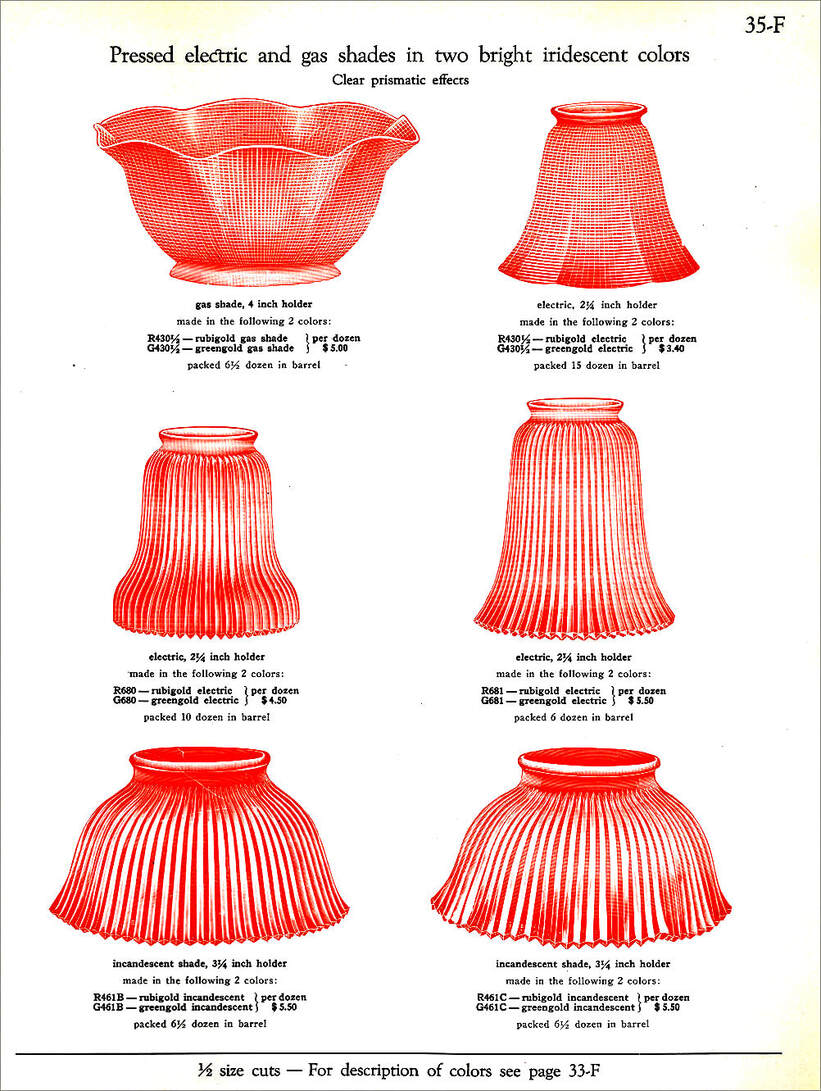Imperial Carnival "Bright Iridescent" Shades
The catalogue pages shown here are all courtesy and Copyright of Jon D. Bartell.
|
Shown below are colour pages from Imperial's Catalog 104-F, "Pressed Glassware for Illumination", dated around 1918. The shades on these four catalogue pages, 34-F to 37-F are all listed as "pressed electric and gas shades in two bright, iridescent colors". As Imperial described them: "the shades illustrated ... are furnished in these two brilliant colors ["Rubigold" and "Greengold]". Imperial's descriptions of these colours is shown at the bottom of this page. |
The use of the notation " ½ " in the catalogue pattern numbers on pages 34-F and 35-F is fascinating. It referred to the way the circular holes at the top of
|
the shades was finished off to remove any roughness from the moulding. It was explained elsewhere in the catalogue, in this way - see right:
A reamer is a precision rotary cutting tool designed to enlarge the size of a previously formed hole by a small amount but with a high degree of accuracy to leave smooth sides. The use of a file however (presumably by hand) to remove any surplus glass, would have left a rougher finish. It's fascinating the Imperial referred to these shades as being a "cheap" product! |
Above: the patterns shown on the page are:
Starlyte - #199½ (top row)
La Rochelle (aka #474 / Four Seventy Four) - #474½ (middle row). Note - this is NOT the Mayflower pattern.
August Flower - #486½ (bottom row)
Starlyte - #199½ (top row)
La Rochelle (aka #474 / Four Seventy Four) - #474½ (middle row). Note - this is NOT the Mayflower pattern.
August Flower - #486½ (bottom row)
Above: the patterns shown on the page are:
Fine Crosshatch - #430½ (top row)
Fine Ribbed - #680 / #681 and #461 (middle and bottom rows)
Fine Crosshatch - #430½ (top row)
Fine Ribbed - #680 / #681 and #461 (middle and bottom rows)
Above: the patterns shown on the page are:
Block and Daisy - #663, #660 and #661 (top row). Helen Greguire called this pattern “Imperial Daisy”.
Buzz Saw - #566, #567 and #581 (bottom row)
Block and Daisy - #663, #660 and #661 (top row). Helen Greguire called this pattern “Imperial Daisy”.
Buzz Saw - #566, #567 and #581 (bottom row)
Above: the patterns shown on the page are:
Stippled Rib (also called Stippled with Clear Pillars) - #657 and #658 (top left and centre)
Optic Flute with Frosted Grapes (OMN) - #669 (top right)
Diamond Block also known as Mount Vernon (OMN) described as a “prism pattern” - #699 (bottom row, left)
Imperial #575 (fluted pattern, bottom row, centre)
Imperial Grape - #473 (bottom row, right)
Stippled Rib (also called Stippled with Clear Pillars) - #657 and #658 (top left and centre)
Optic Flute with Frosted Grapes (OMN) - #669 (top right)
Diamond Block also known as Mount Vernon (OMN) described as a “prism pattern” - #699 (bottom row, left)
Imperial #575 (fluted pattern, bottom row, centre)
Imperial Grape - #473 (bottom row, right)
Here is the way Imperial described these two iridescent colours.
Imperial's Catalog 104-F also included more Carnival Glass shades - "Glassware for Illumination" shades and more "NUART" shades (pressed, decorated and hand-cut). The links to these pages are shown below.
Want to see more about Imperial's Carnival Glass Shades, or Imperial's Carnival Glass generally?
Click on any of the images below:
Click on any of the images below:













